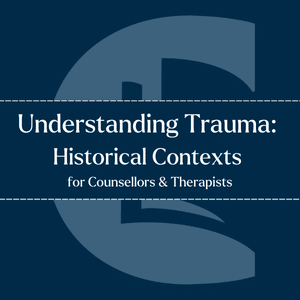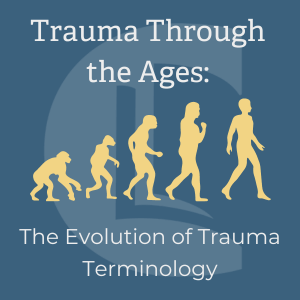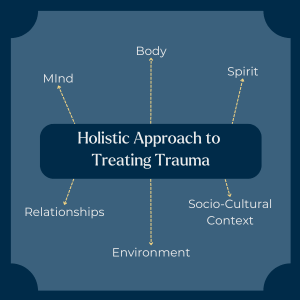Trauma Informed Practice Course
The Competence and Confidence to Work with Trauma in Your Practice.
The following article is taken from our Trauma-Informed Practice course.

The Competence and Confidence to Work with Trauma in Your Practice.
Trauma has been a part of the human experience for millennia, yet our understanding and categorisation have evolved significantly. For counsellors and psychotherapists in the UK, it’s crucial to appreciate the historical context of trauma to provide effective, empathetic care. By exploring how trauma has been depicted in literature and its journey to becoming a recognised psychological disorder, practitioners like yourself can gain valuable insights into the language and frameworks that shape your practice today.
This article encapsulates the evolution of trauma understanding and its implications for practice, tailored for UK-based counsellors and psychotherapists.
Understanding Trauma: Historical Contexts

The human narrative has long included trauma, even if people did not always recognise or name it as such. In ancient texts, we find numerous examples of individuals experiencing what we would now recognise as trauma. For instance, the Epic of Gilgamesh (circa 2100 BC) provides one of the earliest known accounts of trauma. After the death of his close friend Enkidu, Gilgamesh is depicted as being consumed by grief, experiencing what might today be classified as intrusive memories, a hallmark of post-traumatic stress disorder (PTSD). This early literary example highlights that trauma has always been a fundamental part of human existence. Even if not understood as we conceptualise it now, trauma was still present throughout history.
Similarly, in Greek literature, the historian Herodotus described the case of Epizelus, an Athenian soldier. He fought in the Battle of Marathon in 490 BC. Epizelus suddenly went blind after witnessing the death of a fellow soldier, despite not suffering any physical injury. Herodotus attributed this blindness to overwhelming fear, clearly indicating that people recognised the psychological impacts of trauma, even if they didn’t fully understand them. This account reminds us that people have observed symptoms now associated with PTSD for millennia, even without a formal diagnostic framework.
Beyond the classical world, the Icelandic sagas, such as the Saga of Gísli Súrsson, also depict characters who experience recurring nightmares and distress following traumatic events, further emphasising that the phenomenon of trauma transcends cultures and epochs. These ancient texts are a testament to the enduring nature of trauma and the universal struggle to cope with its effects.

The understanding and terminology of trauma has evolved significantly over the centuries, especially in military contexts where the effects of trauma have often been most visible. During the 17th century, Swiss physician Dr Johannes Hofer coined the term “nostalgia” to describe Swiss mercenaries who exhibited symptoms of severe homesickness, anxiety, and insomnia.
These symptoms align closely with what we now recognise as PTSD. This early attempt to categorise and understand the psychological impact of trauma on soldiers marked a significant step in the evolution of trauma terminology.
As the horrors of war expanded with modern warfare, new terms emerged to describe the psychological toll on soldiers. During World War I, the term “shell shock” was used to describe the psychological distress experienced by soldiers exposed to the relentless artillery bombardments of the trenches. This term, while primitive by today’s standards, represented an important acknowledgement of the psychological wounds inflicted by war. The terminology evolved further during World War II, with terms like “combat fatigue” and “battle exhaustion” used to describe similar conditions.
The Vietnam War brought about yet another shift in terminology. The unique and often horrific experiences of soldiers during this conflict led to terms like “Vietnam stress” and “Vietnam syndrome.” These terms highlighted the long-term psychological impacts of war, setting the stage for the eventual recognition of PTSD as a distinct mental health disorder in the 1980s.
The formal recognition of PTSD as a distinct disorder occurred relatively recently, with its inclusion in the third edition of the Diagnostic and Statistical Manual of Mental Disorders (DSM-III) in 1980. This recognition was a landmark moment in the field of mental health, as it provided a standardised framework for diagnosing and treating trauma-related disorders. Vietnam War veterans struggling with the psychological aftermath of their service drove the inclusion of PTSD in the DSM-III. They sought recognition and treatment for their symptoms, leading to this significant change.
The formalisation of PTSD significantly changed how both clinicians and the public understood and treated trauma. It shifted the focus from viewing trauma as a personal failing or moral weakness to recognising it as a legitimate mental health condition requiring professional intervention. This shift validated the experiences of countless trauma survivors and laid the groundwork for more specialised, effective treatment approaches.
However, while the recognition of PTSD was a significant step forward, it also introduced certain limitations. The process of formalising trauma into a specific set of diagnostic criteria has sometimes led to an over-reliance on labels. This can potentially reduce the nuanced understanding of each individual’s unique experience. For therapists, this raises important questions about balancing diagnostic tools with focusing on the individual client’s lived experience. The challenge is using a PTSD diagnosis as a helpful framework without overshadowing each client’s complex personal narrative.
Today, the understanding of trauma continues to evolve, informed by ongoing research, clinical practice, and trauma survivors’ lived experiences. People now widely recognise and use the term PTSD in both clinical settings and popular discourse, reflecting a broader societal awareness of the impact of trauma. This widespread recognition has contributed to developing more trauma-informed approaches in various fields, including healthcare, education, and social services.
Modern trauma theory emphasises the importance of understanding trauma as a response to overwhelming stress that can affect anyone. It’s not a condition limited to soldiers or victims of extreme violence. This broader perspective has led to the recognition of complex PTSD, a condition that arises from prolonged exposure to trauma, often involving multiple incidents over time. Examples include cases of childhood abuse or domestic violence.
Furthermore, the rise of trauma-informed care has underscored the need for a holistic approach to treating trauma. This approach recognises that trauma affects not just the mind but the body and spirit as well, and it advocates for treatment that addresses all aspects of a person’s experience. Therapists are encouraged to consider the full spectrum of their clients’ lives. This includes relationships, environment, and socio-cultural context when developing treatment plans.

In conclusion, the understanding of trauma has come a long way from its early depictions in ancient literature to its formal recognition in modern psychiatry. As counsellors and psychotherapists, it is crucial to remain aware of this history. This awareness informs our current practices and helps us provide more compassionate, effective care. By balancing diagnostic tools with a deep appreciation for each client’s unique story, we can advance trauma treatment. This approach ensures we truly meet the needs of those we serve.
Understanding the historical context of trauma is essential for counsellors and psychotherapists. It enriches the practitioner’s perspective and enhances the therapeutic relationship by fostering a deeper appreciation of the client’s experiences. Reflecting on trauma’s historical descriptions encourages professionals to balance diagnostic labels with respect for clients’ individual stories.
Understanding Trauma – Historical Contexts for Counsellors & Therapists
Linscott, A. (2022). PTSD and Vietnam Veterans. Hill & Ponton Disability Attorneys. Available from: https://www.hillandponton.com/ptsd-and-vietnam-veterans/
Pollard, H. B., et al. (2016). ‘Soldier’s Heart’: A Genetic Basis for Elevated Cardiovascular Disease Risk Associated with Post-traumatic Stress Disorder. Frontiers in Molecular Neuroscience. Available from: https://www.frontiersin.org/articles/10.3389/fnmol.2016.00087/full
Notice any broken link or issues with this resource? Kindly let us know by email
Email us